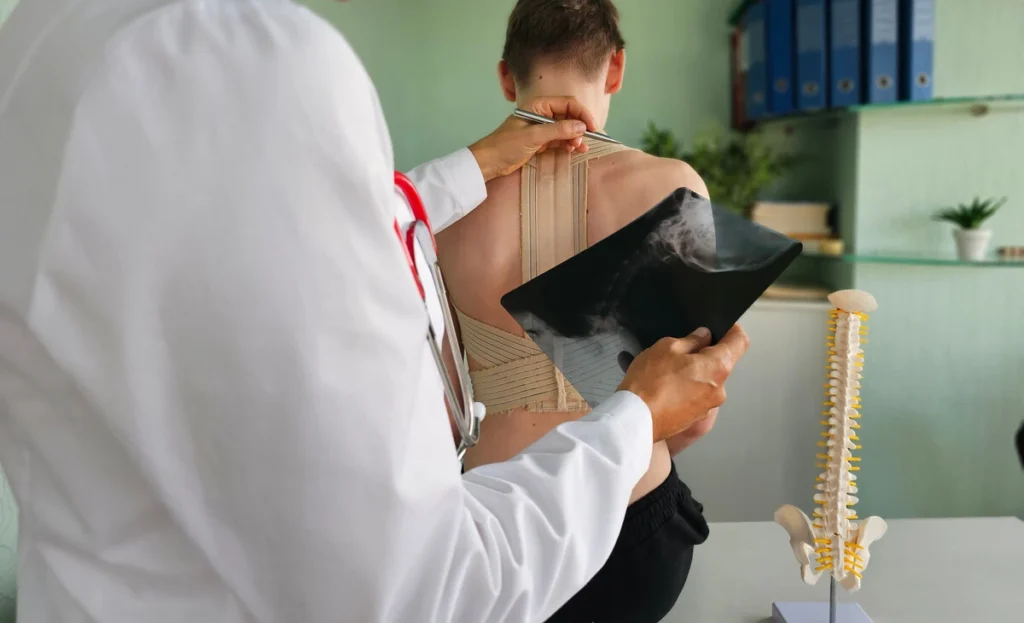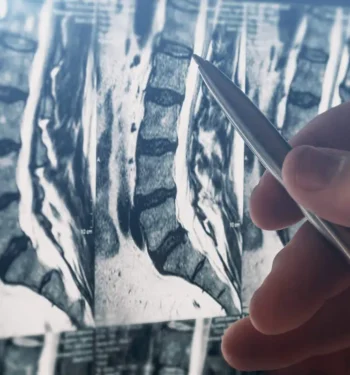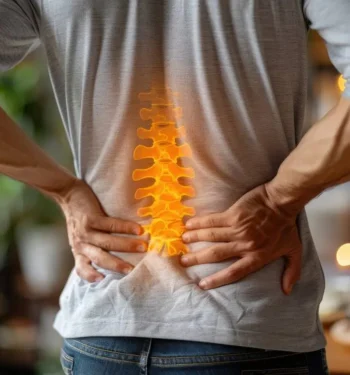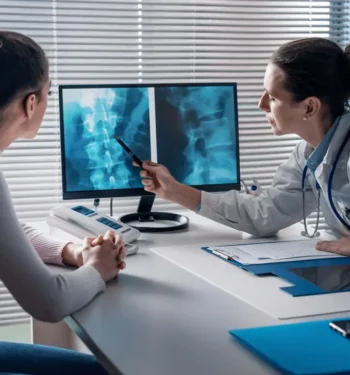
Understanding your spinal stenosis surgery and recovery process is crucial for achieving the best outcomes. Combined, your care team, family or friends, and expert clinicians like those at Goodman Campbell can — and should — all play essential roles in your healing journey.
This guide covers key aspects of spinal stenosis treatment for Indiana patients, from surgery recovery timelines to interventional pain management strategies. For comprehensive patient education and personalized care, be sure to ask your doctor about Goodman Campbell.
How Long Does Spinal Stenosis Take to Heal After Surgery?
Two questions that patients often ask:
- How long is spinal stenosis surgery? Most procedures take 1–3 hours, depending on complexity.
- What is the typical hospital stay? Most patients experience a spinal stenosis surgery hospital stay of 1–3 days, while some cases are done on an outpatient basis.
Spinal stenosis healing time varies by individual and procedure type. The initial recovery phase generally lasts 2–6 weeks, followed by early healing over 3–6 months, and long-term recovery up to one year.
Minimally invasive spinal stenosis surgery recovery time is typically shorter than open procedures, with patients often returning to light activities within 2–4 weeks versus 6–8 weeks for open surgery.
Factors that impact healing time include age, overall health, extent of spinal nerve compression, and adherence to physical therapy. Recovery milestones include returning to daily activities within 4–6 weeks and noticeable pain relief by 3 months.
To discuss your condition and future recovery, request an appointment at Goodman Campbell.
How Painful Is the Recovery From Spinal Stenosis Surgery?
Recovery pain varies but is typically moderate initially, decreasing steadily over weeks. What pain management options are available? Examples of effective postoperative pain management include prescribed pain medications, ice therapy, adequate rest, and professional care. Physical therapy may also be part of a postoperative program.
A physical therapist may also be part of a recovery plan to address issues like muscle stiffness and ensure a smooth healing process. Procedures using minimally invasive surgery techniques generally result in less discomfort than traditional methods.
Minimally invasive procedures generally result in less spine surgery pain than traditional surgery. Contact your provider if pain worsens or doesn’t improve as expected, and remember that Goodman Campbell care includes comprehensive interventional pain management resources throughout your recovery.
What Is The Single Best Exercise for Spinal Stenosis?
Postoperative spine exercises should include guided physical therapy for spinal stenosis, which helps reduce pain, improve mobility, and promote safe healing. Walking is widely regarded as the best exercise for spinal stenosis after surgery. In fact, walking after spinal surgery can boost circulation and support healing without stressing the spine. Also critical to recovery are gentle stretching and core strengthening, both of which are key to a successful recovery and can help restore strength and mobility.
Goodman Campbell’s postoperative exercise guides provide structured programs tailored to your recovery stage. Always consult your doctor before starting any new exercise routine.
What Not to Do After Spinal Stenosis Surgery?
After spinal stenosis surgery, it’s important to follow key surgery precautions, including avoiding certain movements — especially bending, twisting, and heavy lifting — for at least 6–12 weeks; your care team will provide a more specific timeframe. Patients should also generally avoid driving while on pain medication and returning to work too soon.
Recognizing spinal healing activities to avoid and understanding what not to do after spinal stenosis surgery helps prevent complications. Ignoring postsurgery restrictions increases the risk of delayed healing, surgical site issues, or the need for revision surgery. Not following restrictions can complicate recovery and prolong your return to normal activities.
To help you stay on track, Goodman Campbell provides clear patient education and ongoing support for a smooth recovery.
What Is the Most Successful Surgery for Spinal Stenosis?
Spinal stenosis surgery options include several common procedures, with the most successful surgery for spinal stenosis depending on the patient’s condition and overall health. A laminectomy relieves pressure by removing bone or ligament causing compression, while fusion surgery stabilizes segments that have become unstable. Minimally invasive spine surgery techniques aim to achieve similar results with smaller incisions and faster recovery.
At Goodman Campbell, many patients have shared success stories — from improved mobility to reduced pain — after procedures tailored to their condition and lifestyle. Spinal stenosis surgery success rates vary based on factors including age, bone health, activity level, and how closely post-op instructions are followed.
To determine the best surgical option for your needs, consult a true back and spine specialist at Goodman Campbell for expert guidance and personalized care.
Can Spinal Stenosis Heal Without Surgery?
Spinal stenosis recovery without surgery is often possible through conservative treatments, including physical therapy, medications, epidural injections, and lifestyle modifications.
Nonsurgical spinal stenosis healing time varies widely, from weeks to months. Physical therapy without surgery can improve symptoms in many patients, with conservative treatments generally working best for mild to moderate stenosis.
Spinal stenosis healing time without surgery depends on individual factors such as age, activity level, and consistency with treatment. Surgery is recommended when conservative treatments fail, symptoms worsen, or neurological deficits develop. Request an appointment at Goodman Campbell for a comprehensive evaluation and to discuss nonsurgical options.
Conclusion
Successful spinal stenosis surgery recovery depends on following medical guidance, maintaining realistic expectations, and utilizing proper support systems. Spine surgery recovery requires patience, dedication, and expert care throughout the healing process. Follow-up appointments and continued care are essential for optimal outcomes. Lean on your support system during challenging recovery periods.
For a personalized recovery plan and expert Goodman Campbell support, make an appointment today to access comprehensive spine care options that can help you return to an active lifestyle with less pain.



